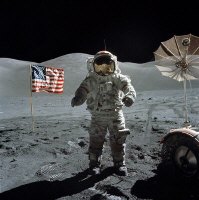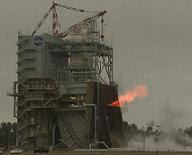Yes, but... What about the "
International Star Registry?"
Such was the power of the Will of Pope Alexander VI that in 1493, barely a year after the European discovery of the Americas, while still exceptionally ignorant of their true extent, their range or even their location, let alone their golden Empires, at that moment manifested in the
Inca and
Aztec, that he could still set upon the Globe a longitudinal
Line of Demarcation separating the future claims of both loyal Portugal and Spain in the "New World."
Five centuries later, east of that Line is Portuguese-speaking Brazil while generally
west of that Line, in the far larger part of South America, Spanish is spoken, even by descendants of the
Inca and
Aztec.
Such was the power of a man who, beginning with an abstraction, and who would never visit those lands or know more than
next-to-nothing about their extent, could still have a
very lasting effect on the course of history.
The law may be a metaphor, but it is "
a metaphor with teeth."
This
Demarcation, however, also included an area we know (and by the power of
one mapmaker) as
North America - which was included inside the Division given to Spain. One tribe of the hundreds of millions of aboriginal
Indios, nomads of the North American Plains who had been Mountain
Utes who would later learn the power of the horse and become known to the Spanish as
Comanche, or "
those who are always against us," kept the Spanish out of Texas for two centuries. Meanwhile, the Protestant English gradually became
de facto owners of the eastern seaboard of North America.
Both groups simply failed to reconcile themselves to foreign ecclesiastical supremacy, and their long conflict, between Iron and Stone Age peoples, had its inevitable result. In the United States, English predominates, despite the Pope's declaration. The bloodiest battles in the subsequent history of all the Americas would be fought between English-speaking descendants and over the status of slaves imported from Africa.
Still further north, the French held sway, and in Quebec
their language is spoken today. Thus, the range of Alexander VI's influence was indeed lasting, but it had its practical limits also, as did the dictates of European Empires over their colonies.
Now, in deciding who "owns" the myriad New Worlds
in this star system alone, there are lessons to be learned from history about the long arm of recognized authority and the limitations of symbolic abstractions on ink on paper thousands of miles away, in both space and time.
The Winter 2008
Journal of Space Law & Commerce from
Southern Methodist University School of Law, delivers a scholarly review of the notion of private claims on Lunar and other extraterrestrial Real Estate.
The authors make the case that an earth-bound authority could encourage space settlement by recognizing the apportionment of lands as incentive for people to act, a method used to hasten the completion of the Trans- Continental Railroad in the United States, and helped along by the recognition of parcels and townships on either side of the easement while deeding their Mineral Rights to private Trusts and corporations.
Claims that might have been made by some of my
Indio ancestors were crippled, naturally, by their lack of any cultural understanding of a
Chain of Title and by their genuine horror even at the thought of Mineral Rights.
There are other ways, more chaotic perhaps than may be comfortable to the authors or to the United Nations. In North Carolina, for example, the unchallenged squatting upon someone else's property for 17 years or more can
become ownership when a claim is afterwards simply filed at the county courthouse. (The reparation later awarded Aboriginal Americans, however, after millennial "squatting" on parts of North America is apparently the right to operate a Casino.)
 Gene Cernan at the beginning of the last EVA on the moon, in the Taurus-Littrow Valley, December 1972. (Image Credit - Jack Schmitt)
Gene Cernan at the beginning of the last EVA on the moon, in the Taurus-Littrow Valley, December 1972. (Image Credit - Jack Schmitt)
Selling the moon, like EM spectrum auctions which have netted the U.S. federal government $64 Billion, is also asking for trouble.
Extraterrestrial land transactions in general are almost certain to lead to ridiculous conflicts and/or impossible or expensive-to-enforce litigation, between absent owners, or nations and nationals, who mine anothers claim.
The Outer Space Treaty puts signatories under an obligation to share data collected by exploration, but no one said this would have to be done in "real time." This creates a market for "insider trading."
And so on... Frustration over such problems, however, along with the persistant, ancient illusions of a Collective, rationalized by terrestrial pressures to "share resources" with the less intrepid may eventually lead to such "hands-off" disincentives to settlement as is seen today in Antarctica, a terrible model for exploiting off-world resources - which might one day prevent the sale of minerals taken from the asteroids, for example, in the only market in this star system, down here in Earth's Gravity Well.
Putting outer space Real Estate in the hands of the United Nations would accomplish the opposite intented by the authors. It would be a disincentive.
The only incentive model that may be workable, in both the short run and the long run, is real people on real property, Boots on the Ground, and mutual agreements made in "township" by those parties in situ - with written agreements made on the land itself, by people who wear spacesuits, not suits and ties, to get to the bargaining table.
Agreements in Townships may exclude absent "authorities" from de facto Eminent Domain or specifically exclude claims by absent owners, and be accompanied by agreements to mutual defense. The latter may seem ridiculous today, but humans are adept at innovating warfare.
You may already see a "War for Lunar Independence" may occur and sooner rather than later. It may have already begun.
Authority, presumed or otherwise, on the part of any Nation-State or International Body, with a Monopoly of Force and written on paper to extend off-Earth must diminish in inverse-proportion to the square of its distance. Earth's Moon may, therefore, be too close for intrepid pioneers.
While the nations of Earth spend relatively little to "explore," history shows they will spend $10 Trillion to enforce proven claims to resources valuing $100 Trillion. When it comes to Power, "Zero-Sum Economies" are quickly tossed aside.
Declaring Space Entrepreneurs to be "privateers," and enforcing Trade Restrictions, preventing access to free markets, may be the best and perhaps the only practical way they might enforce their future treaties - a ball and chain on the speed of our becoming a space-faring species.
Then again, one other way would be to restrict access to Launch and Re-entry windows before they can foresee a loss of bureaucratic control over potential off-world resources; something already well-established in existing Space Law and Regulation.
 In the days when NASA's last three Apollo missions were scrapped, if you don't count Apollo-Soyuz as "Apollo 18," the agency had ambitions for a more glorious future. They were keen to maintain their booster capacity, and grasped at various straws.
In the days when NASA's last three Apollo missions were scrapped, if you don't count Apollo-Soyuz as "Apollo 18," the agency had ambitions for a more glorious future. They were keen to maintain their booster capacity, and grasped at various straws.








 From the Silo and Frontier Astronautics
From the Silo and Frontier Astronautics






